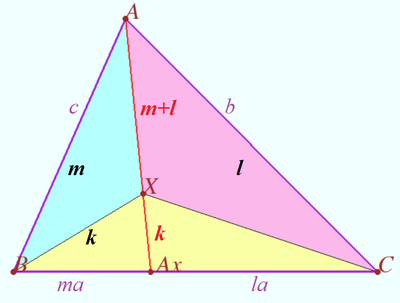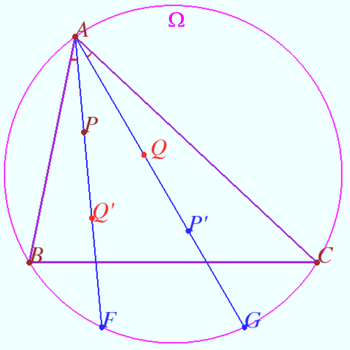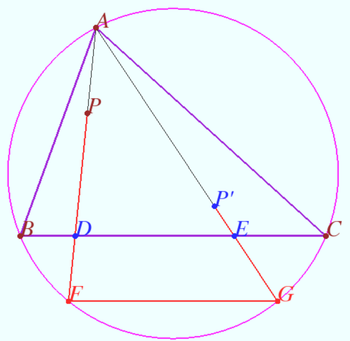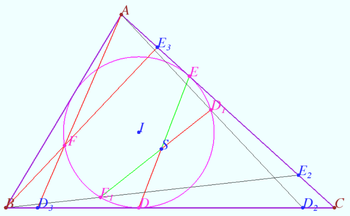Difference between revisions of "Barycentric coordinates"
(→Point on incircle) |
(→Point on incircle) |
||
| Line 144: | Line 144: | ||
<i><b>Proof</b></i> | <i><b>Proof</b></i> | ||
| − | <cmath>I = (a : b : c), S = (b+c : a +c : a+b), D = \left(0 : a+b-c : a-b+c \right), D_1 = (x : y : z ).</cmath> | + | <cmath>I = (a : b : c), S = (b+c : a +c : a+b),</cmath> <cmath>D = \left(0 : a+b-c : a-b+c \right), D_1 = (x : y : z ).</cmath> |
We calculate distances (using NBC) and solve the system of equations: | We calculate distances (using NBC) and solve the system of equations: | ||
<math>ID_1^2 = ID^2, SD_1^2 = SD^2.</math> | <math>ID_1^2 = ID^2, SD_1^2 = SD^2.</math> | ||
| Line 152: | Line 152: | ||
<cmath>D_2 = \left(0 : (a-b)^2 \cdot(b+c-a) : (b-c)^2 \cdot(b+a-c) \right) \implies </cmath> | <cmath>D_2 = \left(0 : (a-b)^2 \cdot(b+c-a) : (b-c)^2 \cdot(b+a-c) \right) \implies </cmath> | ||
<cmath>D_3 = \left(0 : (b-c)^2 \cdot(b+a-c): (a-b)^2 \cdot(b+c-a) \right) . </cmath> | <cmath>D_3 = \left(0 : (b-c)^2 \cdot(b+a-c): (a-b)^2 \cdot(b+c-a) \right) . </cmath> | ||
| − | Similarly <cmath>E_3 = \left((b-c)^2 \cdot(b+a-c) : 0 : (a-b)^2 \cdot(b+c-a) \right) \implies </cmath> | + | Similarly <cmath>E_3 = \left((b-c)^2 \cdot(b+a-c) : 0 : (a-b)^2 \cdot(b+c-a) \right) \implies </cmath> |
Therefore <cmath>F = \left(\frac {(b-c)^2}{b+c-a} : \frac{(a-c)^2}{a+c-b} : \frac{(a-b)^2}{a+b-c}) \right).</cmath> | Therefore <cmath>F = \left(\frac {(b-c)^2}{b+c-a} : \frac{(a-c)^2}{a+c-b} : \frac{(a-b)^2}{a+b-c}) \right).</cmath> | ||
We calculate the length of the segment <math>FI</math> and get <math>FI^2 = r^2.</math> | We calculate the length of the segment <math>FI</math> and get <math>FI^2 = r^2.</math> | ||
Revision as of 14:00, 30 August 2023
This can be used in mass points. http://mathworld.wolfram.com/BarycentricCoordinates.html This article is a stub. Help us out by expanding it.
Barycentric coordinates are triples of numbers ![]() corresponding to masses placed at the vertices of a reference triangle
corresponding to masses placed at the vertices of a reference triangle ![]() . These masses then determine a point
. These masses then determine a point ![]() , which is the geometric centroid of the three masses and is identified with coordinates
, which is the geometric centroid of the three masses and is identified with coordinates ![]() . The vertices of the triangle are given by
. The vertices of the triangle are given by ![]() ,
, ![]() , and
, and ![]() . Barycentric coordinates were discovered by Möbius in 1827 (Coxeter 1969, p. 217; Fauvel et al. 1993).
. Barycentric coordinates were discovered by Möbius in 1827 (Coxeter 1969, p. 217; Fauvel et al. 1993).
The Central NC Math Group published a lecture concerning this topic at https://www.youtube.com/watch?v=KQim7-wrwL0 if you would like to view it.
Useful formulas
Notation
Let the triangle ![]() be a given triangle,
be a given triangle, ![]() be the lengths of
be the lengths of ![]()
We use the following Conway symbols:
![]() is semiperimeter,
is semiperimeter, ![]() is twice the area of
is twice the area of ![]()
![]() where
where ![]() is the inradius,
is the inradius, ![]() is the circumradius,
is the circumradius,
![]() is the cosine of the Brocard angle,
is the cosine of the Brocard angle,
![]()
Main
For any point in the plane ![]() there are barycentric coordinates(BC):
there are barycentric coordinates(BC): ![]() :
:
![]()
![]() The normalized (absolute) barycentric coordinates NBC satisfy the condition
The normalized (absolute) barycentric coordinates NBC satisfy the condition ![]() they are uniquely determined:
they are uniquely determined:
![]()
![]() Triangle vertices
Triangle vertices ![]()
The barycentric coordinates of a point do not change under an affine transformation.
Lines
The straight line in barycentric coordinates (BC) is given by the equation ![]()
The lines given in the BC by the equations ![]() and
and ![]() intersect at the point
intersect at the point
![]()
These lines are parallel iff ![]()
The sideline ![]() contains the points
contains the points ![]() its equation is
its equation is ![]()
The line ![]() has equation
has equation ![]() it intersects the sideline
it intersects the sideline ![]() at the point
at the point ![]()
Iff ![]() then
then ![]()
Let NBC of points ![]() and
and ![]() be
be ![]()
Then the square of distance ![]()
![]() The equation of bisector of
The equation of bisector of ![]() is:
is:
![]() Nagel line :
Nagel line : ![]()
Circles
Any circle is given by an equation of the form ![]()
Circumcircle contains the points ![]() the equation of this circle:
the equation of this circle: ![]()
The incircle contains the tangent points of the incircle with the sides:
![]()
The equation of the incircle is
![]() where
where ![]()
The radical axis of two circles given by equations of this form is:
![]() Conjugate
Conjugate
The point ![]() is isotomically conjugate with respect to
is isotomically conjugate with respect to ![]() with the point
with the point ![]()
The point ![]() is isogonally conjugate with respect to
is isogonally conjugate with respect to ![]() with the point
with the point ![]()
The point ![]() is isocircular conjugate with respect to
is isocircular conjugate with respect to ![]() with the point
with the point ![]()
Triangle centers
The median ![]() centroid is
centroid is ![]()
The simmedian point ![]() is isogonally conjugate with respect to
is isogonally conjugate with respect to ![]() with the point
with the point ![]()
The bisector ![]() the incenter is
the incenter is ![]()
The excenters are ![]()
The circumcenter ![]() lies at the intersection of the bisectors
lies at the intersection of the bisectors ![]() and
and ![]() its BC coordinates
its BC coordinates ![]()
The orthocenter ![]() is isogonally conjugate with respect to
is isogonally conjugate with respect to ![]() with the point
with the point ![]()
Let Nagel point ![]() lies at line
lies at line ![]()
The Gergonne point is the isotomic conjugate of the Nagel point, so ![]()
vladimir.shelomovskii@gmail.com, vvsss
Product of isogonal segments
Let triangle ![]() the circumcircle
the circumcircle ![]() and isogonals
and isogonals ![]() and
and ![]() of the
of the ![]() be given.
Let point
be given.
Let point ![]() and
and ![]() be the isogonal conjugate of a point
be the isogonal conjugate of a point ![]() and
and ![]() with respect to
with respect to ![]() Prove that
Prove that ![]()
Proof
We fixed ![]() and the point
and the point ![]() So isogonal
So isogonal ![]() is fixed.
is fixed.
Denote ![]()
We need to prove that ![]() do not depends from
do not depends from ![]()
Line ![]() has the equation
has the equation ![]()
To find the point ![]() we solve the system this equation and equation for circumcircle:
we solve the system this equation and equation for circumcircle: ![]()
![]() We use the formula for isogonal cobnjugate point and get
We use the formula for isogonal cobnjugate point and get
![]() and then
and then ![]()
![]() We calculate distances (using NBC) and get:
We calculate distances (using NBC) and get:
![]()
![]() where
where ![]() has sufficiently big formula.
has sufficiently big formula.
Therefore ![]() vladimir.shelomovskii@gmail.com, vvsss
vladimir.shelomovskii@gmail.com, vvsss
Point on incircle
Let triangle ![]() be given. Denote the incicle
be given. Denote the incicle ![]() the incenter
the incenter ![]() , the Spieker center
, the Spieker center ![]()
Let ![]() be the point corresponding to the condition
be the point corresponding to the condition ![]() is symmetric
is symmetric ![]() with respect midpoint
with respect midpoint ![]()
Symilarly denote ![]()
Prove that point ![]() lies on
lies on ![]()
Proof
![]()
![]() We calculate distances (using NBC) and solve the system of equations:
We calculate distances (using NBC) and solve the system of equations:
![]()
We know one solution of this system (point D), so we get linear equation and get:
![]()
![]()
![]() Similarly
Similarly ![]() Therefore
Therefore ![]() We calculate the length of the segment
We calculate the length of the segment ![]() and get
and get ![]()
The author learned about the existence of such a point from Leonid Shatunov in August 2023.
vladimir.shelomovskii@gmail.com, vvsss













